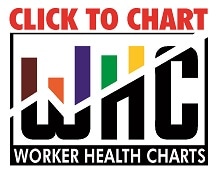About the Pesticide Surveillance Program
About the NIOSH Pesticide Surveillance Program
NIOSH uses a few different data sources to monitor the trends in acute pesticide-related illness and injury that occur on the job. Here you will learn how we use data from the SENSOR-Pesticides program and the National Poison Data System to keep workers safe.
NIOSH and the SENSOR-Pesticides Program
The mission of the Sentinel Event Notification System for Occupational Risk (SENSOR) program is to build and maintain occupational illness and injury surveillance capacity within state health departments. One of the illnesses supported under SENSOR is acute occupational pesticide-related illness and injury. The SENSOR-Pesticides program is most useful for identifying outbreaks and emerging pesticide problems. Under this program, NIOSH provides cooperative agreement funding and technical support to state health departments to conduct surveillance on one or more occupational illnesses or injuries. Funding support for the SENSOR-Pesticides program is also provided to NIOSH by EPA.
A total of 13 states participate in the SENSOR-Pesticides program:
- California *
- Florida **
- Illinois *
- Iowa **
- Louisiana **
- Michigan *
- Nebraska **
- New Mexico **
- New York **
- North Carolina **
- Oregon **
- Texas *
- Washington *
* Receives federal funding and NIOSH technical support to bolster pesticide-related illness and injury surveillance
** Receives technical support from NIOSH, federally unfunded SENSOR-Pesticides partners
If your state is interested in participating in this program, please contact us
A database was created to maintain the data from this effort. The SENSOR-Pesticides data set is useful to assess the magnitude and trend of acute occupational pesticide-related illness and injury. The database consists of acute occupational pesticide-related illness and injury cases submitted by the SENSOR-pesticides states in 1998 to 2011. A portion of the database is available in our new charting feature, Worker Health Charts, which allows you to chart the data.
Using the National Poison Data System to Assess Pesticide Poisonings
Within the United States, poison control centers receive phone calls reporting instances of poison exposure to adults and children. These centers serve all 50 states and the District of Columbia. The National Poison Data System (NPDS) documents every phone call the centers receive.
NIOSH uses NPDS data† to track acute work-related pesticide poisonings, which is one of 22 Occupational Health Indicators. The Occupational Health Indicators were defined by the Occupational Health Surveillance Work Group that consists of NIOSH staff and state occupational health professionals working under the support of the Council of State and Territorial Epidemiologists (CSTE) . CSTE is an organization of member states and territories representing public health epidemiologists, and it works to establish more effective relationships among state and other health agencies. Map the rate of acute work-related pesticide poisonings that occurred during 2006-2013.
How These Efforts Have Made a Difference
The SENSOR-Pesticides program is recognized nationally as providing critical information for occupational and public health. The impacts from this effort include:
- Changes in Federal Regulations to Reduce Pesticide-related Health Risks: In September 2015, the US Environmental Protection Agency (EPA) announced final revised rules to the Worker Protection Standard (WPS), the federal regulations to reduce pesticide-related health risks among agricultural workers. This was the first major WPS revision in 20 years. SENSOR-Pesticides findings are extensively cited in the revised rules.
- Changes in Proposed Federal Regulations to Improve the Training and Certification of Pesticide Applicators: In December 2016, EPA announced final revised regulations for certification and training of pesticide applicators to ensure the competent use of “restricted use” pesticides (i.e. pesticides that can be purchased only by competent pesticide applicators). This was the first major revision to these regulations in 40 years. Findings from SENSOR-Pesticides are extensively cited in the announcement. EPA stated that the proposed new requirements will provide health benefits to pesticide applicators, agricultural workers, and the public.
- Safer Pest Control in Schools: After a SENSOR-Pesticides journal article on the national incidence of pesticide poisoning at schools was published, five states passed laws requiring schools to control pests using methods with the least possible health hazards.
- Improved Labels on Pesticide Products: Findings by SENSOR-Pesticides led to label changes for countless pesticide products to enhance clarity and improve safety, and passage of state laws in California, Florida, and North Carolina to provide greater protection from pesticide hazards.
Learn more about the SENSOR-Pesticides program.
† The NPDS data is updated every other year.

